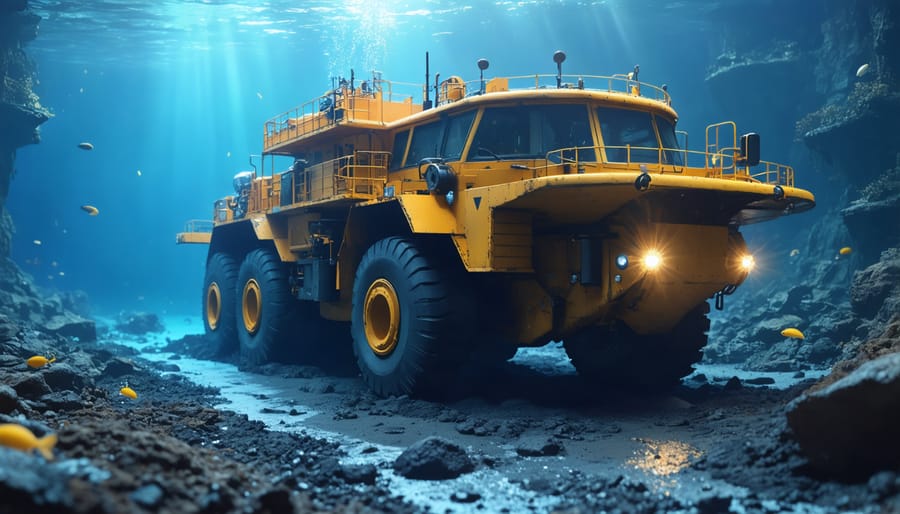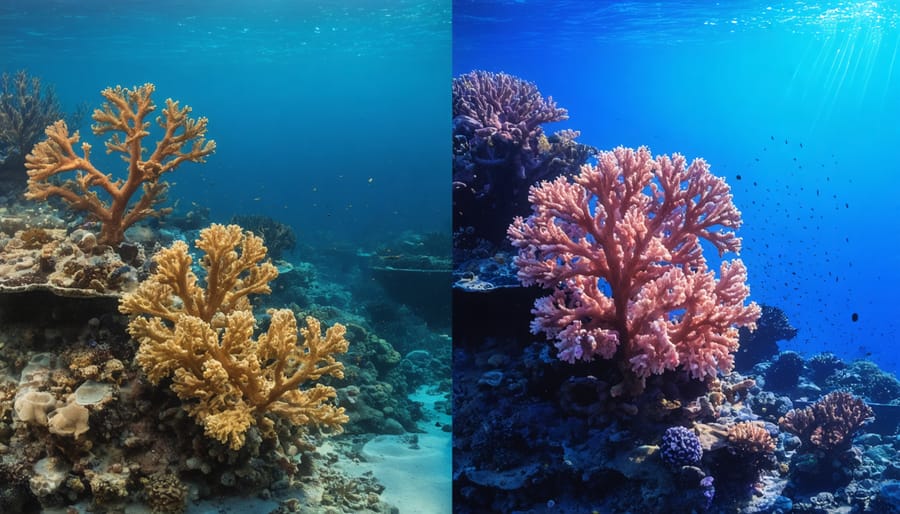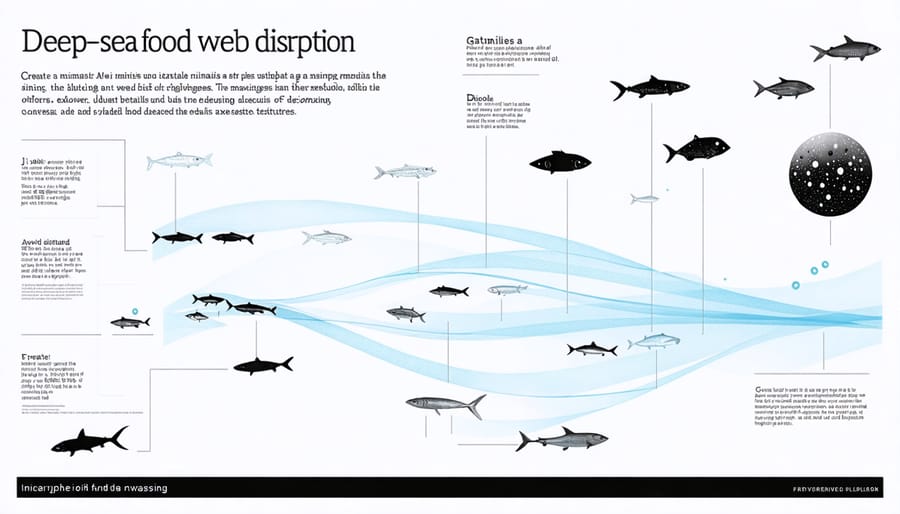
As mining companies push deeper into Earth’s final frontier, the environmental risks of deep-sea mining threaten to irreversibly damage one of our planet’s most pristine and least understood ecosystems. Three kilometers beneath the ocean’s surface, valuable minerals lie scattered across vast underwater plains and seamounts – deposits that have taken millions of years to form. Yet these same areas host remarkably diverse communities of ancient deep-sea creatures, many still unknown to science. From crushing deep-water coral reefs to releasing toxic sediment plumes that can travel hundreds of kilometers, industrial-scale mining operations pose unprecedented risks to marine biodiversity. As global demand for rare earth elements and battery metals surges, we stand at a critical crossroads: do we prioritize short-term mineral extraction, or protect these unique deep-ocean habitats that help regulate our climate, support fish populations, and may hold undiscovered medical breakthroughs? This article examines the full scope of environmental impacts from deep-sea mining operations and explores sustainable alternatives for meeting our resource needs without sacrificing irreplaceable marine ecosystems.
The Deep-Sea Mining Process: Understanding the Basics
Mining Technologies and Methods
Deep-sea mining employs sophisticated equipment designed to extract valuable minerals from the ocean floor. The primary method involves massive remote-operated vehicles (ROVs) equipped with collecting systems that traverse the seafloor, gathering polymetallic nodules or scraping hydrothermal vent deposits. These machines, often the size of small houses, use powerful pumps and grinding mechanisms to break up and collect mineral-rich materials.
The typical mining process begins with surveying vehicles mapping the seafloor to identify resource-rich areas. Collection vehicles then move across the seabed, using either hydraulic suction systems or mechanical cutting tools to gather materials. The collected ore is pumped through a vertical riser system – essentially a giant tube extending from the seafloor to the surface vessel – where it’s dewatered and stored for transport.
Current technology includes nodule collectors with wide tracks or wheels that minimize pressure on the seafloor, and advanced filtering systems designed to reduce sediment dispersion. However, even these “environmentally conscious” designs still disturb vast areas of seabed and create substantial sediment plumes that can travel for kilometers through deep ocean currents.

Target Resources and Locations
Deep-sea mining primarily targets three valuable mineral deposits found in different ocean zones. Polymetallic nodules, potato-sized rocks rich in manganese, nickel, copper, and cobalt, lie scattered across vast abyssal plains at depths of 4,000-6,000 meters. These nodules are particularly abundant in the Clarion-Clipperton Zone of the Pacific Ocean, spanning 4.5 million square kilometers between Hawaii and Mexico.
Cobalt-rich crusts form on the slopes of seamounts, typically at depths of 800-2,500 meters. These deposits are concentrated in the Prime Crust Zone of the Pacific Ocean, containing valuable metals essential for renewable energy technologies and electronic devices.
The third target is seafloor massive sulfides, found near hydrothermal vents at depths of 1,500-5,000 meters. These deposits, rich in copper, zinc, gold, and silver, are primarily located along the Ring of Fire in the Pacific Ocean and the Mid-Atlantic Ridge.
Currently, the International Seabed Authority has issued exploration contracts covering over 1.5 million square kilometers of the ocean floor, with particular focus on the Pacific Ocean’s mineral-rich zones.
Direct Environmental Impacts
Physical Habitat Destruction
Deep-sea mining operations cause devastating physical damage to the seafloor, permanently altering these pristine deep-sea ecosystems that have evolved over millions of years. The process involves massive machines that scrape, crush, and collect mineral-rich deposits, leaving behind a barren landscape devoid of life.
The immediate impact is the complete destruction of seafloor habitats, including ancient coral gardens, sponge fields, and unique geological formations like hydrothermal vents. These structures, which took centuries or even millennia to form, provide crucial shelter and breeding grounds for countless marine species, many of which remain undiscovered by science.
Mining vehicles create deep trenches and sediment plumes that can extend for kilometers, burying delicate filter-feeding organisms and smothering entire communities of bottom-dwelling creatures. The compaction of the seafloor by heavy machinery also permanently alters its physical structure, making it impossible for many species to recolonize the area.
Perhaps most concerning is the destruction of seamounts and deep-sea nodule fields, which act as stepping stones for species migration and genetic exchange across ocean basins. Once these habitats are destroyed, the recovery time – if recovery is possible at all – is estimated to span hundreds or thousands of years.
Marine biologists have observed that even small-scale test mining operations can create lasting scars on the seafloor. Areas disturbed by experimental mining in the 1970s still show minimal signs of recovery today, highlighting the long-term consequences of habitat destruction in these slow-growing environments.

Sediment Plumes and Water Column Effects
The release of sediment plumes during deep-sea mining operations poses one of the most significant threats to marine ecosystems. As massive machines disturb the seafloor, they create clouds of fine particles that can remain suspended in the water column for extended periods, spreading far beyond the immediate mining site.
These suspended sediments affect marine life in multiple ways. Filter-feeding organisms, including corals, sponges, and many deep-sea invertebrates, become particularly vulnerable as sediment clogs their feeding apparatus. The reduced visibility in sediment-laden water disrupts the hunting abilities of visual predators and interferes with species that rely on bioluminescence for communication and reproduction.
Marine scientists have observed that sediment plumes can travel hundreds of kilometers from their source, carried by deep-sea currents. This widespread dispersal means that even species living far from mining sites face potential impacts. The settling of these particles onto marine organisms can smother them, preventing proper respiration and feeding.
The increased turbidity also affects the penetration of light in the water column, disrupting the delicate balance of deep-sea ecosystems. Even in naturally dark environments, many organisms rely on specific light conditions for their daily activities and life cycles. Research has shown that sediment plumes can alter the chemical composition of the water, potentially changing pH levels and oxygen availability.
Recovery from sediment plume impacts can take decades or even centuries, as deep-sea species typically grow and reproduce very slowly. Scientists emphasize the need for comprehensive environmental impact assessments and careful monitoring of sediment dispersion patterns before any large-scale deep-sea mining operations begin.
Long-term Ecosystem Consequences
Species Loss and Recovery Challenges
Deep-sea mining poses a severe threat to marine species, with potential consequences that could lead to irreversible biodiversity loss. Scientists estimate that many deep-sea species remain undiscovered, and mining activities could lead to their extinction before we even document their existence. This presents a unique challenge for marine biodiversity conservation efforts.
The recovery time for deep-sea ecosystems is particularly concerning. Unlike shallow-water environments, deep-sea communities can take decades or even centuries to recover from disturbances. This slow recovery rate is due to several factors, including the extremely slow growth rates of deep-sea organisms and limited nutrient availability in these environments.
Marine biologist Dr. Sarah Chen, who has studied deep-sea communities for over a decade, explains: “When we damage these ecosystems, we’re not looking at a few years of recovery. Some deep-sea coral species grow just millimeters per year. Once destroyed, these ancient communities might never return to their original state.”
The loss of species can trigger cascade effects throughout the food web. Many deep-sea organisms form complex symbiotic relationships, and the disappearance of one species can affect numerous others. Endemic species – those found nowhere else on Earth – are particularly vulnerable, as their extinction would represent a permanent loss to global biodiversity.
Conservation efforts must focus on protecting these vulnerable ecosystems before mining activities begin, as restoration of deep-sea habitats remains technically challenging and prohibitively expensive.
Food Web Disruption
Deep-sea mining poses significant risks to marine food webs, potentially triggering cascading effects throughout entire ocean ecosystems. When mining operations disturb the seafloor, they directly impact bottom-dwelling organisms that form the foundation of deep-sea food chains. These include microscopic organisms, filter feeders, and various invertebrates that larger species depend on for survival.
The disruption extends beyond the immediate mining area through sediment plumes, which can travel for kilometers, affecting feeding patterns and reducing the visibility necessary for predator-prey interactions. Filter-feeding organisms, particularly crucial in deep-sea environments, may struggle to distinguish between food particles and suspended mining sediment, leading to reduced feeding efficiency and potential starvation.
Marine biologists have observed that when key species at lower trophic levels are affected, the impact ripples upward through the food web. For example, if deep-sea corals and sponges are destroyed, the small fish and invertebrates that rely on them for shelter and feeding grounds must relocate or face population decline. This, in turn, affects larger predatory fish, marine mammals, and even species that migrate between different ocean depths.
The interconnected nature of marine ecosystems means that disrupting even a single component can have far-reaching consequences. Recovery from such disturbances can take decades or even centuries, given the slow growth rates and long life cycles characteristic of deep-sea species. Understanding these complex relationships is crucial for developing sustainable mining practices that minimize ecosystem disruption.

Conservation Solutions and Alternatives
Protective Policies and Regulations
Current protective measures for deep-sea mining focus on international regulations and regional agreements, with the International Seabed Authority (ISA) serving as the primary regulatory body. The ISA requires environmental impact assessments and monitoring plans before issuing mining permits, implementing adaptive conservation strategies based on scientific research and environmental monitoring data.
Several nations have established Marine Protected Areas (MPAs) in their territorial waters to safeguard vulnerable deep-sea ecosystems from mining activities. These protected zones serve as refuges for marine species and help maintain biodiversity in adjacent areas. The Clarion-Clipperton Zone, for instance, includes nine designated preservation reference areas where mining is prohibited.
Recent proposals advocate for stricter regulations, including mandatory buffer zones around hydrothermal vents and seamounts, improved environmental monitoring technologies, and more comprehensive baseline studies before mining operations begin. Scientists and conservation groups are pushing for the implementation of the precautionary principle, which requires companies to prove their activities won’t cause significant harm before receiving permits.
Emerging protective measures include the development of eco-friendly mining technologies, establishment of environmental compensation schemes, and creation of international scientific advisory committees to guide policy decisions. These initiatives aim to balance resource extraction with ecosystem preservation, ensuring the protection of deep-sea biodiversity for future generations.
Sustainable Alternatives
As concerns about deep-sea mining grow, researchers and innovators are developing promising alternatives to meet our resource needs while protecting marine ecosystems. Urban mining has emerged as a sustainable solution, focusing on recovering valuable metals from electronic waste and discarded products. This approach not only reduces the need for new mining but also addresses the growing e-waste crisis.
Advances in recycling technologies have made it possible to extract rare earth elements and precious metals from used electronics with increasing efficiency. Companies are now able to recover up to 95% of gold from electronic circuits, and similar processes exist for copper, silver, and other valuable metals.
The circular economy approach offers another viable alternative, emphasizing product design that facilitates easy disassembly and material recovery. Some manufacturers are already implementing these principles, creating products with components that can be easily separated and recycled.
Biomining presents an innovative solution, using microorganisms to extract metals from low-grade ores and waste materials. This process requires less energy and produces fewer environmental impacts compared to traditional mining methods.
Investment in renewable energy technologies is also reducing demand for certain minerals. For instance, new developments in wind turbine design are decreasing the need for rare earth elements, while advanced battery technologies are exploring alternatives to conventional materials.
These sustainable alternatives demonstrate that meeting our resource needs doesn’t have to come at the expense of ocean health.
The environmental impacts of deep-sea mining present a critical challenge for marine conservation in the 21st century. As our research has shown, these activities pose significant risks to delicate deep-sea ecosystems, including the destruction of ancient coral formations, disruption of marine food chains, and potential extinction of species we haven’t yet discovered. The sediment plumes created by mining operations can spread far beyond the immediate mining site, affecting marine life across vast oceanic areas.
However, there is hope for protecting these vital ecosystems. Through collaborative scientific research, technological innovation, and strong international regulations, we can develop more sustainable approaches to obtaining the minerals our society needs. Many organizations are already working to establish protected marine areas and advocate for stricter mining regulations.
You can make a difference by staying informed about deep-sea mining developments, supporting marine conservation organizations, and participating in citizen science projects. Consider joining beach clean-up initiatives, which help prevent additional stress on marine ecosystems, or becoming an advocate for marine protected areas in your region.
The deep sea remains one of Earth’s last frontiers, home to countless undiscovered species and essential ecosystem services. By taking action now, we can ensure these unique habitats survive for future generations. The choices we make today about deep-sea mining will shape the future of our oceans – and by extension, our planet – for centuries to come.
Let’s work together to protect these irreplaceable marine treasures while pursuing sustainable solutions for our resource needs.
jessica
Ava Singh is an environmental writer and marine sustainability advocate with a deep commitment to protecting the world's oceans and coastal communities. With a background in environmental policy and a passion for storytelling, Ava brings complex topics to life through clear, engaging content that educates and empowers readers. At the Marine Biodiversity & Sustainability Learning Center, Ava focuses on sharing impactful stories about community engagement, policy innovations, and conservation strategies. Her writing bridges the gap between science and the public, encouraging people to take part in preserving marine biodiversity. When she’s not writing, Ava collaborates with local initiatives to promote eco-conscious living and sustainable development, ensuring her work makes a difference both on the page and in the real world.
